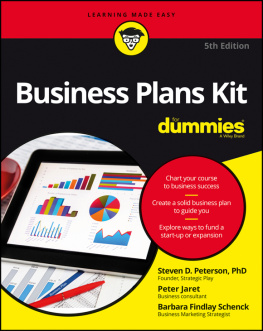Table of Contents
Additional Titles in EntrepreneursMade Easy Series
Accounting and Finance for Small Business Made Easy: Secrets You Wish Your CPA Had Told You by Robert Low
Managing a Small Business Made Easy by Martin E. Davis
Meetings Made Easy: The Ultimate Fix-It Guide by Frances Micale
Strategic Planning Made Easy by Fred L. Fry, Charles R. Stoner, and Laurence G. Weinzimmer
Advertising Without an Agency Made Easy by Kathy J. Kobliski
Preface
For the revised Third Edition ofBusiness Plans Made Easy
Over the past 30 years I have noticed that the most difficult part of writing a business plan is simply getting started. Some people need to know what a business plan is and why its a good idea to have one. Others are unsure of where to begin, what to put in or leave out, who to aim the plan at, how to put it all together, and how to package it. Mark Henricks and John Riddle (authors of the earlier editions of Business Plans Made Easy) did a fine job addressing these concerns. I have tried to maintain their reasoning and structure while adding a few thoughts of my own.
Business Plans Made Easy is divided into three sections:
1. Before Writing Your Plan
2. Writing Your Business Plan
3. Enhancing Your Business Plan
You dont want to write a business plan in a vacuum. Before writing your plan, you need to have an idea of how you want to use itusually, but not always, this will be to test your business ideas and/or to raise capital to put those ideas to work. This prewriting phase wont lock you into a single use, but it will simplify the writing process if you know at whom your plan is aimed. Is it for your own use? Is it for a banker or other investor?
Writing a business plan is not a linear activity but rather an organic process. Much of the value of a plan lies in the process. As you think, write, and revise your plan, you will get to know more about your business and how it works, which almost always leads to improvements, new insights, and increased profitability. A bright idea in the marketing section may lead to changes in staffing, management, and financial areas. Accordingly, I urge people who are writing their first business plan to buy and use a thick three-ring binder and to set up a business plan document on their computer. Both the binder and the document will have subheads that vary according to the nature of the business. (More on this below.) The binder becomes a useful repository of early thoughts; ideas that are not beneficial today may be useful tomorrow. Although it is easy to keep early drafts on the computer, it is more helpful to print them out and store them in the binder so you can refer back to them. You will be surprised how useful these early drafts are when you assemble the final draft of your business plan (or financing proposal if that is its use). Some of the most valuable information will be the assumptions you make in your financial projections: What were you thinking? Why did you pick this value rather than some other?
The headings are pretty much the same no matter what your business. All business plans have to describe what the business sells (product or service), how it produces that product or service (operations, personnel, management, equipment, and capital), how it identifies and serves a market (who the customers are, why they will buy from this business instead of a competitor), how it will attract and retain those customers (marketing and promotion), and how all the numbers add up to a profit (financial statements and projections). A manufacturing company will have detailed information on operations and production processes. A retailer will be more concerned with location and selling practices, including training and appearance of sales staff. You choose your subheadsbut be sure to include the four Cs:
1. Concept. What is the business about? What is its history and future?
2. Customers. Who are they? Why will they buy?
3. Competition. All business is competitive.
4. Cash. No business can run without cash, and only financial discipline as embodied in the financial statements can make sure you dont run out of cash!
If you have followed along so far and have jotted down a few subheads, youve accomplished the most difficult part of writing a business plan. Youve gotten started.
One common misapprehension about business plans is that the hardest part is dealing with the financial statements. Bear in mind that help is more readily available for the financial part of the plan than for the narrative part. The financial statements and projections express the thinking and research of the first parts of the plan, those parts in which you lay out how the business will use its assets to attract and retain a customer base sufficient to make a profit over the long haul. Bankers, accountants, and other experts are more than capable of helping you create a model of your business and how it works in standard financial terminology and formats. If you are not comfortable with this aspect of the plan, by all means avail yourself of expert advice. The financial model you create in your business plan will repay your efforts a thousand fold. You can use the model to create what-if scenarios, to convince investors to put their money in your venture, to test ideas, and to create budgets to control cash.
What should be the focus of your business planning efforts? Thats easyon marketing. All good business plans contain a good marketing plan. Think about it. The purpose of your business is to make money. Without customers who are able and willing to buy your product or service at a price that affords you a decent profit, you wont be in business for long, no matter how much capital you begin with. Shrewd investors (you included) want to make sure that every effort has been or will be taken to identify, reach, and retain that invaluable customer base. Everything in your businessits organization, its operations, and its staffing and financingrevolves around the customer. Therefore, it makes sense to focus your planning efforts on this central issue. The rest then follows.
Good luck with your business plan!
Andy Bangs
Portsmouth, NH
Introduction
EACH CHAPTER IN THIS BOOK IS DEVOTED TO ANALYZING, EXPLAINING, and wherever and whenever possible, making entertaining an important concept relating to business plans. The chapter topics range from why you even need a plan to what to do with it when youre finished. Youll learn techniques for figuring your break-even ratio and tips for approaching potential investors. Youll hear stories about the business plans of famous entrepreneurs and even learn about a few entrepreneurs who admit that they dont write planswillingly, at least.
Along the way, youll find definitions of important terms, contact information for useful resources, warnings of especially common or serious mistakes, and pointers to steer you in the right direction. When youve finished, youll be prepared to write a sound, comprehensive, convincing plan for almost any business, whether its a brand-new start-up or an existing company. More important, however, youll be the owner of a thoroughly prepared mind and need just the slightest nod from good fortune to proceed.
















